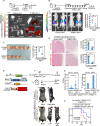GREB1 isoform 4 is specifically transcribed by MITF and required for melanoma proliferation
- PMID: 37658191
- PMCID: PMC10575781
- DOI: 10.1038/s41388-023-02803-6
GREB1 isoform 4 is specifically transcribed by MITF and required for melanoma proliferation
Abstract
Growth regulation by estrogen in breast cancer 1 (GREB1) is involved in hormone-dependent and -independent tumor development (e.g., hepatoblastoma). In this study, we found that a GREB1 splicing variant, isoform 4 (Is4), which encodes C-terminal half of full-length GREB1, is specifically expressed via microphthalmia-associated transcription factor (MITF) in melanocytic melanoma, and that two MITF-binding E-box CANNTG motifs at the 5'-upstream region of GREB1 exon 19 are necessary for GREB1 Is4 transcription. MITF and GREB1 Is4 were strongly co-expressed in approximately 20% of the melanoma specimens evaluated (17/89 cases) and their expression was associated with tumor thickness. GREB1 Is4 silencing reduced melanoma cell proliferation in association with altered expression of cell proliferation-related genes in vitro. In addition, GREB1 Is4 targeting by antisense oligonucleotide (ASO) decreased melanoma xenograft tumor formation and GREB1 Is4 expression in a BRAFV600E; PTENflox melanoma mouse model promoted melanoma formation, demonstrating the crucial role of GREB1 Is4 for melanoma proliferation in vivo. GREB1 Is4 bound to CAD, the rate-limiting enzyme of pyrimidine metabolism, and metabolic flux analysis revealed that GREBI Is4 is necessary for pyrimidine synthesis. These results suggest that MITF-dependent GREB1 Is4 expression leads to melanoma proliferation and GREB1 Is4 represents a new molecular target in melanoma.
© 2023. The Author(s).
Conflict of interest statement
The authors declare no competing interests.
Figures







Similar articles
-
Simultaneous suppression of MITF and BRAF V600E enhanced inhibition of melanoma cell proliferation.Cancer Sci. 2009 Oct;100(10):1863-9. doi: 10.1111/j.1349-7006.2009.01266.x. Epub 2009 Jun 29. Cancer Sci. 2009. PMID: 19659611 Free PMC article.
-
Expression of genes for microphthalmia isoforms, Pax3 and MSG1, in human melanomas.Cell Mol Biol (Noisy-le-grand). 1999 Nov;45(7):1075-82. Cell Mol Biol (Noisy-le-grand). 1999. PMID: 10644012
-
Oncogenic mutation in RAS-RAF axis leads to increased expression of GREB1, resulting in tumor proliferation in colorectal cancer.Cancer Sci. 2020 Oct;111(10):3540-3549. doi: 10.1111/cas.14558. Epub 2020 Aug 31. Cancer Sci. 2020. PMID: 32629543 Free PMC article.
-
MITF in melanoma: mechanisms behind its expression and activity.Cell Mol Life Sci. 2015 Apr;72(7):1249-60. doi: 10.1007/s00018-014-1791-0. Epub 2014 Nov 30. Cell Mol Life Sci. 2015. PMID: 25433395 Free PMC article. Review.
-
MITF, the Janus transcription factor of melanoma.Future Oncol. 2013 Feb;9(2):235-44. doi: 10.2217/fon.12.177. Future Oncol. 2013. PMID: 23414473 Review.
Cited by
-
The emerging roles of glutamine amidotransferases in metabolism and immune defense.Nucleosides Nucleotides Nucleic Acids. 2024;43(8):783-797. doi: 10.1080/15257770.2024.2351135. Epub 2024 May 14. Nucleosides Nucleotides Nucleic Acids. 2024. PMID: 38743960 Free PMC article. Review.
-
A system to analyze the initiation of random X-chromosome inactivation using time-lapse imaging of single cells.Sci Rep. 2024 Sep 2;14(1):20327. doi: 10.1038/s41598-024-71105-y. Sci Rep. 2024. PMID: 39223177 Free PMC article.
References
MeSH terms
Substances
LinkOut - more resources
Full Text Sources
Medical
Molecular Biology Databases
Research Materials
Miscellaneous

